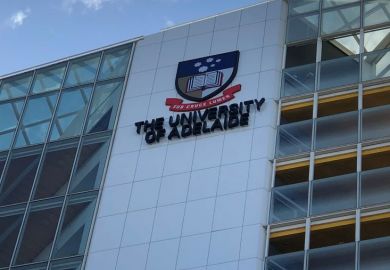If you were to ask people what they expect from a high-quality university, there would be myriad opinions.
Most would see the university as pivotal to giving students an equal opportunity to become the best they can be, irrespective of their financial and broader social circumstances.
Most would expect the university to make improvements to society through research of the highest quality flowing into improved products, services, productivity, sustainability and well-being.
More recently, there has rightly been an increasing focus on doing all this while also delivering an outstanding student experience and ensuring the future success of graduates.
Attaining such a triple helix is difficult – particularly when national policy settings provide funding models that value one over the other or each to an insufficient and inconsistent level. But we do not believe that it is impossible. We believe that, in South Australia, we can do just that.
This is the journey we are embarking on as we pursue the creation of a new university through amalgamation of the University of Adelaide and the University of South Australia – exploring structural change of a scale that probably hasn’t been seen in higher education across the world for many years.
Indigenous Australian First Nations peoples have lived in this region for more than 50,000 years – with countless generations of connection to the land and to place. Only very recently, in 1836, did South Australia take form as a British colony, and it is still home to only 1.8 million people – about 1/37th of the UK population.
More than three-quarters of those 1.8 million live in the greater metropolitan Adelaide region. The University of Adelaide (UoA), the continent’s third higher education institution, was established there in 1874, and the city remains the primary base of operation for South Australia’s three public universities.
In the late 1980s and early 1990s, a series of higher education reforms instigated by the then federal education minister, John Dawkins, saw the creation of new universities from the amalgamation of colleges of advanced education and institutes of technology. In Adelaide, this ultimately gave rise to the creation of the University of South Australia (UniSA) in 1991 – but there were any number of courtships and near-misses that could have seen a myriad of differently structured higher education institutions emerge had things not landed as they did.
In the subsequent 32 years, UniSA and UoA have cooperated and competed as academic and professional rivals, each successful in their own right and delivering against distinct but compatible and overlapping missions. But as a consequence of the sometimes cutthroat nature of academic politics – as well, perhaps, as rose-coloured hindsight – it wasn’t very long after those Dawkins-era reforms had been enacted that talk began about whether it would actually have made more sense to amalgamate UniSA with UoA.
This became if not a perennial topic of discussion then certainly one that regularly recurred – usually coincident with the retirement or departure of one or other of the institutions’ vice-chancellors. In an almost prescient twist of fate, one such occasion eventuated in late 2011, with the departure of a UoA vice-chancellor and one of us, Peter Høj, leading UniSA.
For a variety of reasons, the idea of amalgamation was not realised at the time, and that outcome was one reason Peter left UniSA in 2012 to take the role of vice-chancellor at the University of Queensland. His replacement at UniSA was the other author of this article, David Lloyd.
In 2018, following a leadership change at UoA, merger talk once again stepped out from the backroom shade and into the light. The two universities published a discussion paper and invited public submissions before UniSA withdrew from the exploration, citing the lack of a compelling business case to progress.
Another change in leadership in 2020 precipitated further short-lived debate on the manner in which South Australian universities might be reorganised to advance the economy and competitiveness of the state, but in the midst of what was then an emerging pandemic other priorities understandably held sway.
Unbeknown to the universities, however, the leader of South Australia’s Labor opposition, Peter Malinauskas, had himself been contemplating the value of a potential merger of universities since 2018’s “failure”. Without any input from the institutions, he announced his party’s first pre-election policy position in late 2020, succinctly titled A South Australian University Merger.
The policy stated that should an “independent Commission determine that a university merger is in the interest of the South Australian economy and the welfare of the people of the state, then a merger will be a first term priority for a Labor Government”. The sitting Liberal Government had previously expressed support for whatever determination the universities might make about amalgamations, so there appeared to be no stated political opposition to the concept being advanced.
In February 2021, the fates intervened once more. Upon his retirement from Queensland, Peter returned to South Australia and somewhat unexpectedly found himself appointed vice-chancellor of UoA, following a difficult period in its history. Rife speculation that he had been recruited with the sole objective of progressing a merger could not have been further from the truth, but March 2022 saw a landslide election win for Malinauskas and, with it, a clear public mandate for the promised “merger commission”.
Universities in South Australia are explicitly not agencies of government. They are independent corporate bodies, established through state legislation with stipulated functions and objectives, but wholly autonomous and self-accrediting. Their governing bodies (councils) have clear and specific obligations to act as they see fit to further the universities’ best interests.
It was through such autonomous lenses that, independently and separately, the councils determined that proactively determining their own future was preferential to a potential loss of agency through any intervention suggested by a third party or merger commission. So we were sanctioned to engage with one another to, without prejudice, explore what would be possible. And over a six-month period, we planned, debated and pushed one another’s boundaries around what could be achieved together should a green light be given to an amalgamation.
Between us, we have led three different universities for a quarter of a century, as well as having led national research bodies (David in his native Ireland). We are both migrants, both the first in our families to attend university and both advocates for access and equity in higher education. In addition, we are both passionate about the future of South Australia. So it is perhaps unsurprising that we rapidly aligned on a shared vision.
It is at this stage that a movie of a certain genre would cut to a montage of late-night brainstorming sessions, complete with whiteboards, post-it notes and suspiciously clean-looking coffee mugs – likely accompanied by an uplifting theme song. Such a montage would encapsulate neatly the thousands of person-hours – all the iterations, working groups and negotiations; all the crossed thresholds and sudden epiphanies – that enabled two disparate management groups, who had never previously shared the same room, to sign off on a shared plan, expressed in a single set of documents, for how to transition from two similarly sized large institutions to a new single university.
That plan, built around a vision for the delivery of a new, for-purpose Australian institution, was presented separately to the two councils. Those councils independently assessed it and each determined that the new university would be in the interest of both their individual university and the people of the State of South Australia. Accordingly, they independently resolved to support the Malinauskas government’s policy intent to bring about mergers through legislative change.
The state government, reviewing the costs and benefits, agreed to put the necessary legislation to the Parliament and pledged to invest about A$440 million (£230 million) – the largest investment in higher education in the state’s history – to de-risk what is one of the biggest university amalgamations ever undertaken. That legislation is now being considered by a State parliamentary committee. When it opens its doors on 1 January 2026, legislation and regulations permitting, Adelaide University, as it will be known, will be the largest educator of domestic students in Australia, with more than 70,000 enrolled students in total.
But while we’ve determined that this is the right thing to do, we’ve never been down this road before, and there is no map to follow. Over the next two and a half years, however, we hope to do our best to sketch one. We intend to send you regular postcards – via Times Higher Education – from our waypoints as we navigate this rarely trodden territory.
We’ve a long way to travel, but, as so often in South Australia, it promises to be quite a journey.
David Lloyd is vice-chancellor of the University of South Australia. Peter Høj is vice-chancellor of the University of Adelaide. They are the co-v-c team building the new Adelaide University.
Register to continue
Why register?
- Registration is free and only takes a moment
- Once registered, you can read 3 articles a month
- Sign up for our newsletter
Subscribe
Or subscribe for unlimited access to:
- Unlimited access to news, views, insights & reviews
- Digital editions
- Digital access to THE’s university and college rankings analysis
Already registered or a current subscriber?








